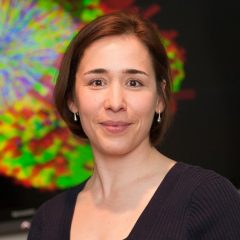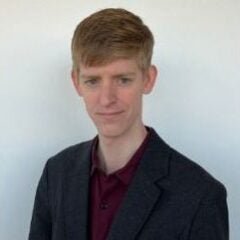Dr. Olga Evdokimov

Olga Evdokimov is a Professor of Physics and Co-director of Undergraduate Studies at the University of Illinois – Chicago. She received her PhD in 1999 from Joint Institute for Nuclear Research (Dubna, Russia) and Ivanovo State University (Ivanovo, Russia). Her research is focused on the experimental exploration of phases of nuclear matter. She is involved with two experimental programs with the STAR (Solenoid Tracker at RHIC) detector at the Relativistic Heavy Ion Collider (RHIC) and CMS (Compact Muon Solenoid) detector at the Large Hadron Collider (LHC), studying the properties of Quark Gluon Plasma (QGP). Her research interests span a variety of subjects, and include investigating the collision dynamics, hadronization mechanisms in QGP, statistical jet reconstruction and jet-medium interactions. In 2016 she was elected as a Chair of the STAR Collaboration Council, and is currently serving in this position. She is also serving as a member of the Nuclear Science Advisory Committee to the US Department of Energy and the National Science Foundation.
Phone : (312) 996-3413
Email : evdolga@uic.edu
Dr. Austin Baty

Austin Baty is Assistant Professor ath the University of Illinois Chicago. He completed his Bachelor’s degree in Physics and Math from Texas A&M University in 2013, and received his Ph.D. in Physics in 2019 from MIT, where he was a School of Science Fellow. Professor Baty studies a form of incredibly hot, dense matter that existed only a microsecond after the Big Bang, known as the Quark-Gluon Plasma (QGP). As a member of the CMS Collaboration, Austin and his colleagues experimentally create and examine this matter in a laboratory setting using high-energy collisions of heavy ions at the Large Hadron Collider (LHC) in Geneva, Switzerland. More generally, Austin is interested in how the complex phenomena exhibited by the QGP can emerge from the underlying theory of the strong force, Quantum Chromodynamics (QCD). He plans to use the massive data sets produced by CMS during the LHC Run 3 (2022-2025) and Run 4 (2029-2032) to tackle this question.
Phone : (312) 413-2781
Email : abaty@uic.edu
Dr. David Hofman
Prof. Hofman’s area of scientific research is experimental high-energy nuclear physics, also often called high-energy “heavy-ion” physics. He is interested in creating and studying a new phase of matter, called the “quark gluon plasma”, which is believed to have existed at the birth of our universe. This research is carried out at two large colliders, the Relativistic Heavy Ion Collider (RHIC) at Brookhaven National Laboratory in New York and the Large Hadron Collider (LHC) accelerator at CERN in Switzerland. The experimental nuclear physics group’s research at RHIC is carried out within the STAR collaborations and their research at the LHC is carried out within the CMS collaboration. Professor Hofman was also a member of the PHOBOS collaboration, which measured p p, d Au, Cu Cu, and Au Au collisions at RHIC, and the E917 collaboration, which measured relativistic Au Au collisions at 6, 8 and 10.8 AGeV at the AGS.
Phone : (312) 413-2798
Email : hofman@uic.edu